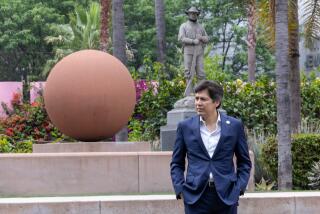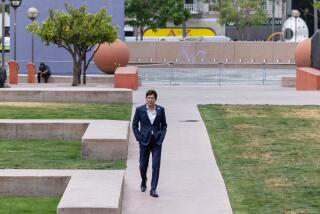Dealey Plaza: A place Dallas has long tried to avoid and forget

Dealey Plaza, the site of JFK’s assassination, is a curious hybrid of intersection and accidental monument, an unlovely, architecturally unresolved prick on the Texas city’s conscience.
DALLAS — I hadn’t been standing in Dealey Plaza more than five minutes when I watched a man dash out into the street to pose for a picture. He was heading straight for a white X in the pavement that marks the location of John F. Kennedy’s limousine when the 35th president was fatally shot on the afternoon of Nov. 22, 1963.
The man stopped on the X, adjusted his feet and smiled. Then he looked nervously in the direction of oncoming traffic before running back to the safety of the sidewalk.
Apparently, this happens all the time. The late Dallas architecture critic David Dillon was right to describe Dealey Plaza as “one of the most photographed and scrutinized public spaces in America.” But the site of the assassination is not, as you might imagine if you’ve never been to Dallas, an open square where conspiracy theorists and Warren Commission devotees can stroll together in animated argument.
It is not a place where you can quietly lay a bunch of flowers at the foot of a Kennedy statue, since there is no Kennedy statue here. The city’s official JFK Memorial, designed by architect Philip Johnson and completed in 1970, isn’t in Dealey Plaza itself but in a separate public square about 200 feet to the east, behind the old red-brick county courthouse.
Dealey Plaza is instead a curious mixture: part high-traffic intersection, part gateway to the city, part flood-control project, and part accidental historical monument.
Although a modest two-phase project to restore the plaza’s New Deal landscape and pergolas is nearly complete, the upgrades won’t give the space any real sense of coherence. When crowds gather next month to mark the 50th anniversary of the assassination, they’ll be occupying a part of the city that was designed more for cars than pedestrians — and that many Dallas residents have tried their best to avoid and forget.
Dealey Plaza is named for George Bannerman Dealey, longtime publisher of the Dallas Morning News. It was created when the Trinity River, which once flowed near this part of Dallas and often flooded, was moved behind a series of levees. That decision, part of a broader planning project begun after an especially severe flood in 1908, opened the western edge of downtown Dallas for new construction.
The wedge-shaped plaza itself, designed in the 1930s, was a hybrid from the beginning. Sloping downhill from the edge of downtown, it has always been dominated by the three streets that slice through it: Elm, Main and Commerce. The streets flow together at the bottom of the hill, where they run under a railroad bridge and form what locals (and Kennedy assassination buffs) know as the “triple underpass.”
In the open space between these roadways, some of which is planted with grass, stand white concrete pergolas and two small fountains. Those features were designed with muted Art Moderne elegance by the firm Hare & Hare in a project overseen by the Works Projects Administration. The plaza was dedicated and named for Dealey in 1935 and completed in 1940.
When the president was shot, his motorcade was driving along Elm, the northernmost of the three streets in the plaza, just where it begins to dip downhill. The Texas School Book Depository, where Lee Harvey Oswald was waiting on the sixth floor with an Italian rifle, rises along Elm and overlooks the plaza.
What happened in the wake of the assassination was that a spot on the edge of Dealey Plaza became its focal point — just as the shooting turned a peripheral site in Dallas into a place of intense scrutiny.
Awkwardly enough, that new focal point happened to be in the middle of a busy three-lane road that officials had no interest in closing to cars. In part their reasoning was practical: It’s a key roadway. It was also connected to the reluctance of many Dallas residents to fully face Kennedy’s killing and its implications for their city’s reputation.
PHOTOS: How TV reacted to JFK’s assassination
As the president toured Texas in 1963, anger over his agenda and the reach of the federal government was building throughout the state. The shooting seemed to confirm that there was a deep reservoir of anger below the placid and prosperous surface of Dallas society. Residents quickly got tired of hearing about Dallas as a “city of hate.”
Over the years, Dealey Plaza languished. Somehow keeping the cars moving along Elm suggested that the city could keep moving along too. The Book Depository was nearly torn down before a group of Dallas residents rallied to save it.
An institution dedicated to Kennedy and the assassination, the Sixth Floor Museum, opened inside the Book Depository in 1989. But at street level little was done. The pergolas cracked and chipped over time.
“As the city grew, Dealey Plaza became the site of neglect,” said Nicola Longford, executive director of the Sixth Floor Museum. “I think it was reinforced by the fact that the site told the story of a very sad time that Dallas has found it difficult sometimes to remember and confront.”
She added, “It is a site that’s well known throughout the world. Our visitors don’t understand why it looks the way it does.”
And those visitors keep coming: roughly a million people visit Dealey Plaza every year, about two-thirds of them from outside Texas. An appellate court ruled in March that the First Amendment gives vendors the right to set up shop in the plaza and sell materials related to the assassination.
The landscaped areas on both sides of that stretch of Elm, including the berm known as the “grassy knoll,” are often manned by conspiracy theorists. One of them, Robert Groden, reportedly first added the white X to the street, indicating the spot over which Kennedy’s limo was driving when he was hit.
The memorial by Philip Johnson, for its part, also symbolizes the city’s deep ambivalence about commemorating the assassination. A spare cenotaph, or open tomb, designed to be built in marble, it was instead cast in cheaper concrete. And its location east of the assassination site suggested an effort to tuck the history of that day away.
“Everyone in town wanted to get away from Dealey Plaza,” said Judith Segura, a historian who helped lead the fundraising effort to repair the site. “They didn’t want the memorial to be right there. They thought that would be ghoulish.”
Dallas architects Good Fulton & Farrell produced a master plan to restore the plaza in 2001. More recent work has been carried out and partly paid for by the city, bringing the total spent to roughly $2.5 million.
“We had to really shame the city into it,” Segura said. “We went to the city and said, ‘Look, we’re going to be the focus of worldwide attention in 2013.’”
Officials ultimately decided to restore the pergolas and fountains to their original design and the landscape — the oak trees, bushes and the grassy knoll itself — to approximate the way it looked on the day of the assassination. The Sixth Floor Museum has produced a cellphone walking tour of the plaza that begins in front of the Book Depository and ends atop the triple underpass.
By the standards of Dealey Plaza’s tortured history, that’s progress of a sort.
For the 90-minute memorial program, which will include remarks by historian David McCullough, Dealey Plaza will be closed to traffic and perhaps temporarily resemble a traditional public plaza.
But after the stages and bleachers come down, Elm Street will be opened up again to cars. And Dealey Plaza will go back to being what it’s been for 50 years: an unlovely, architecturally unresolved prick on the city’s conscience.
If Kennedy had been shot inside a building, it’s possible that Dallas would have demolished it by now — just as the city nearly saw the Book Depository come down. And just as the Los Angeles Unified School District demolished the Ambassador Hotel on Wilshire Boulevard, where Robert F. Kennedy was shot five years after his brother’s death.
So maybe, for the sake of national memory and historic preservation, it’s a stroke of macabre luck that the assassination happened in this ordinary and seemingly forgettable location.
You can’t raze a spot in the air above a stretch of pavement way you can raze a building. You can ignore it or be vexed by it, both of which Dallas has done over the years. But a wrecking ball swinging through empty space doesn’t accomplish much.
More to Read
The biggest entertainment stories
Get our big stories about Hollywood, film, television, music, arts, culture and more right in your inbox as soon as they publish.
You may occasionally receive promotional content from the Los Angeles Times.











